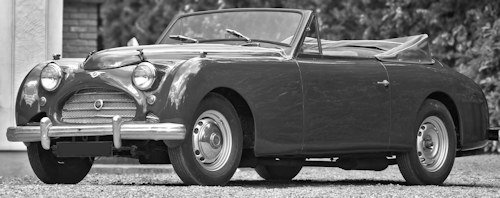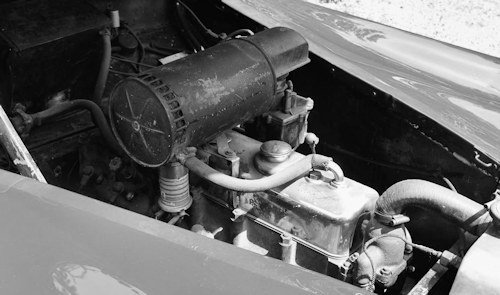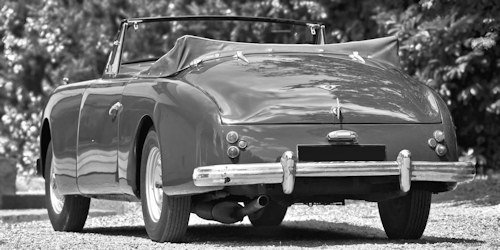Jensen Interceptor original
 |
|
|
Manufacturer |
Jensen |
|
Production |
1950 to 1957 |
|
Class |
Sports car |
|
Produced |
88 produced |
|
Body style |
2-door 4 seat saloon 2-door 4 seat convertible 2-door 4 seat sedan |
|
Engine |
3993 cc in-line 6 cylinder |
|
Transmission |
4 speeds with overdrive from 1952 |
|
Wheelbase |
112 in (2,845 mm) |
|
Length |
183 in (4,648 mm) |
|
Width |
66 in (1,676 mm) |
|
Height |
58 in (1,473 mm) |
|
Designer |
Eric Neale |
The first generation of Jensen Interceptor was built in the 1950s.
History
Available in two models a 4-5-seater saloon or a cabriolet of the same size. Both have two doors.The first generation of Jensen Interceptor was the second car to be made by Jensen Motors after World War II and was produced from 1950 to 1957. Jensen later reused the name for a different car (built from 1966 and revived several times after that). The 1950 Jensen model is entirely new.
The car was based on Austin components with a body built by Jensen and styled by Eric Neale. The engine and transmission came from the Austin Sheerline and the chassis was a lengthened version of the one used on the Austin A70 with a modified version of the independent coil sprung suspension. Jensen also made the Austin A40 Sports which was, in its styling, a scaled down version of the Interceptor.
The two-door body was available at first as a convertible and made from a mix of aluminium and steel on a wood frame. The entire front section hinged forwards to give access to the engine. Lamps and so forth, can be hinged upwards from the scuttle to give unusually easy access to the engine and forward chassis components for major maintenance work such as valve adjustment. The chassis has been made even more rigid by the addition of 5-in. diameter side tubes and the control pedals and steering wheel have been moved forward to give more room in the back seat. Ventilation of both the interior of the car and under the bonnet has been improved by the provision of carefully-sited air in-takes and the side lamps have been transferred to the top of the wings.
The new Interceptor cabriolet with striking lines, with a sweeping full- width body and modern front incorporating built-in head-lamps
and a low radiator grille. It takes the form of an extremely modern-looking two-door cabriolet, with a similar engine to the saloon but a much smaller and lighter chassis providing an exceptionally good power-weight ratio for high performance, coupled with drop-head coachwork. The use a six-cylinder engine three carburettor push-rod-operated carburettor. unit, developing 130 BHP. the use of a hypoid rear axle the chassis is a system of coil springs, radius arms and a Panhard rod at the rear, with, independent front suspension also by coil springs. the familiar Jensen radiator has been cleverly incorporated in the forward portion of the bonnet top. Of the two-door type, the body is planned as a five/six-seater with a front width of 55 ins. and a corresponding dimension at the rear of 47 ins. Thanks to a low- built chassis, it has been possible to keep down the overall height without sacrifice of head room, The hood section being arranged to drop complete into the rear portion of the body when the head is folded.

At the front a system of independent suspension incorporating coil springs and wishbones is used, but at the rear the Interceptor chassis suspension by the use of semi-elliptic springs. Brakes are of the Girling Hydro- mechanical type with two-leading shoes at the front, the Borg and Beck clutch and four-speed synchromesh gearbox with a top ratio of 3.22 to 1 optional overdrive in 1952. When the Laycock de Norman Ville overdrive was fitted a lower, 3.77:1, rear axle gearing was used.The Overdrive is engaged by a sidewaysflick of the centrally-situated, re-mote-control gear lever. You don't have to touch the clutch and the position of the gear lever is such that when you want to dis- engage the overdrive you can do so by gently pressing your left knee against the knob of the lever.
The wrap around rear window was made of rigid plastic (Perspex) and was arranged to drop down into a well for stowage when the top was lowered. In 1952 a hardtop version with fabric covered roof was launched and a few sedans version were also made.In 1952 the car cost £2645 (including tax) on the home market. The overdrive was an extra £116.Total production was 32 convertibles, 52 saloons and 4 sedans.

Technical
-
Jensen Interceptor original Technical details and specifications (1950-1957)
ENGINE:
Cylinders: 6
Bore: 87 mm.
Stroke: 111 mm.
Cubic capacity: 3,993 c.c.
Piston area: 55.3 sq. ins.
Valves: Overhead (pushrod)
Compression ratio: 6.8 to 1
Max BHP at: 130 3,700 r.p.m.
Carburetter: Three SU
Ignition: Coil
Plugs: make and type : Champion N8
Fuel pump: AC mechanical
Fuel capacity: 13 gallons
Oil filter: Tecalemit full flow
Oil capacity: 15 + 2 pints
Cooling system: Pump, fan and thermostat
Electrical system: Lucas 12-volt
Battery capacity: 68 amp./hrs.TRANSMISSION DRIVE LINE:
Clutch: Borg and Beck
Gear ratios: Top: 3.22 3rd: 4.11 2nd: 0.06 1st:11.05 Rev:10.7
Prop. shaft: Hardy Spicer
Final drive: Hypoid bevel
BRAKES:
Brakes Girling Hydro-mech. 2LS on front
Brake drum diameter: 11 ins
Friction lining area: 134.9 sq. ins.SUSPENSION:
Front: Independent (coil)
Rear: Semi-elliptic
Shock absorbers: Armstrong hydraulicSTEERING:
Steering gear: Cam
Turning circle: 38 ft.WHEELS TYRES:
Wheel type: Disc
Tyre size: 5.50 x 16 ins.
DIMENSIONS AND WEIGHT:
Wheelbase: 9 ft. 6 ins.
Track: Front: 4 ft. 9 ins. Rear: 4 ft. 9 ins.
Overall length: 15 ft. 3 ins.
Overall width: 5 ft. 6 ins.
Overall height: 4 ft. 10 ins.
Ground clearance: 8 ins.
Dry weight: 25 cwt© Motor car History
